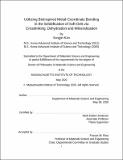| dc.contributor.advisor | Niels Holten-Andersen. | en_US |
| dc.contributor.author | Kim, Sungjin,Ph.D.Massachusetts Institute of Technology. | en_US |
| dc.contributor.other | Massachusetts Institute of Technology. Department of Materials Science and Engineering. | en_US |
| dc.date.accessioned | 2020-10-08T21:29:43Z | |
| dc.date.available | 2020-10-08T21:29:43Z | |
| dc.date.copyright | 2020 | en_US |
| dc.date.issued | 2020 | en_US |
| dc.identifier.uri | https://hdl.handle.net/1721.1/127905 | |
| dc.description | Thesis: Ph. D., Massachusetts Institute of Technology, Department of Materials Science and Engineering, May, 2020 | en_US |
| dc.description | Cataloged from the official PDF of thesis. | en_US |
| dc.description | Includes bibliographical references (pages 104-116). | en_US |
| dc.description.abstract | In nature, most organisms embark on the journey of life in a predominantly soft and compliant state and go through a series of material solidification processes to serve a multitude of complex functions at various life stages. Many of these material transitions occur via an organic-inorganic processing pathway that involves a genetically programmed hierarchy of spatiotemporally orchestrated macromolecular crosslinking, dehydration, and mineralization events. With the growing need for sustainable material processing, the interest has increased in understanding the underlying physical-chemical mechanisms that control the change in properties during such biological material transitions. Hence, in this thesis, we utilized polymers in combination with metal-coordinating ligands to form various types of metal-crosslinked networks as a platform to explore the possibly synergistic roles of crosslinking, dehydration, and mineralization in building solid materials out of soft gels. | en_US |
| dc.description.abstract | First, we explored how metal-coordinate crosslinking contributes to macromolecular material mechanics upon dehydration-induced solidification, using mussel-inspired metal-catechol or metal-histidine crosslinked polymer hydrogels. We found evidence to suggest that a small amount of locally bound water by metal-coordinate complexes maintains their dynamic nature as mechanically dissipative crosslinks even in a dehydrated polymer network. In addition, a scaling relationship between the timescale of macroscopic network relaxation time and the amount of bound microscopic water was elucidated by demonstrating control over the fractions of dynamic and permanent crosslinks within the network. Second, we investigated the relationship between macromolecular crosslinking and mineralization. | en_US |
| dc.description.abstract | Inspired by the self-assembling metal-reinforced mussel holdfast threads, we tested if metal-coordinate polymer networks can be utilized as simple composite scaffolds for direct in situ crosslink mineralization. Starting with aqueous solutions of well-dispersed metal-binding polymers, we found that inter-molecular metal-ion coordination complexes can serve as mineral nucleation sites, whereby significant mechanical reinforcement is achieved upon nanoparticle growth localized at the metal-coordinate network crosslink sites. Finally, we studied the control over mineralization of biominerals using catecholic metal-binding additives. We found that a common edible polyphenol, tannic acid (TA), ubiquitous in natural plants and foods could work as an effective binder for Ca to stabilize amorphous calcium carbonate (ACC). Furthermore, we demonstrated that the TA-induced ACC can readily transition to hydroxyapatites, or bone mineral, in simulated body fluid at human body temperature. | en_US |
| dc.description.statementofresponsibility | by Sungjin Kim. | en_US |
| dc.format.extent | 170 pages | en_US |
| dc.language.iso | eng | en_US |
| dc.publisher | Massachusetts Institute of Technology | en_US |
| dc.rights | MIT theses may be protected by copyright. Please reuse MIT thesis content according to the MIT Libraries Permissions Policy, which is available through the URL provided. | en_US |
| dc.rights.uri | http://dspace.mit.edu/handle/1721.1/7582 | en_US |
| dc.subject | Materials Science and Engineering. | en_US |
| dc.title | Utilizing bioinspired metal-coordinate bonding in the solidification of soft gels via crosslinking, dehydration and mineralization | en_US |
| dc.type | Thesis | en_US |
| dc.description.degree | Ph. D. | en_US |
| dc.contributor.department | Massachusetts Institute of Technology. Department of Materials Science and Engineering | en_US |
| dc.identifier.oclc | 1197627550 | en_US |
| dc.description.collection | Ph.D. Massachusetts Institute of Technology, Department of Materials Science and Engineering | en_US |
| dspace.imported | 2020-10-08T21:29:41Z | en_US |
| mit.thesis.degree | Doctoral | en_US |
| mit.thesis.department | MatSci | en_US |
